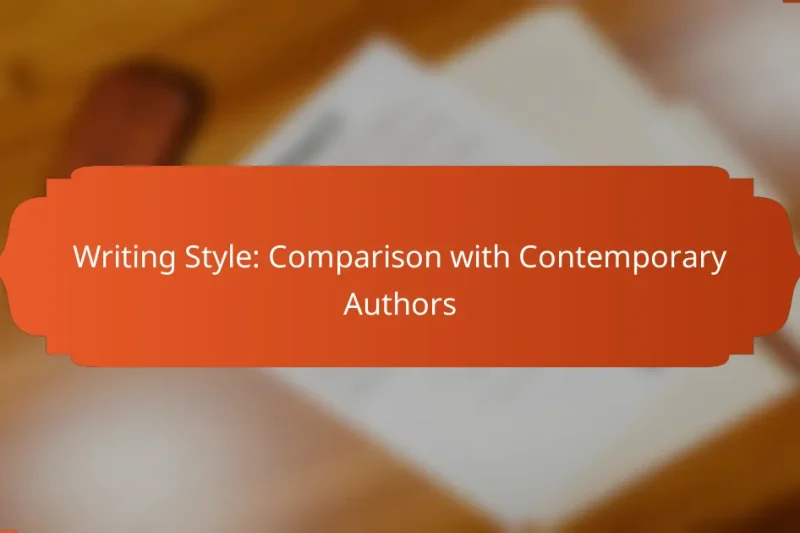Symbolism is a powerful literary and artistic technique that conveys deeper meanings beyond the surface of … Symbolism: Techniques, Impact and InterpretationRead more
Writing Style of 2025
In 2025, writing styles will evolve to prioritize engagement and accessibility, utilizing conversational tones and inclusive language to connect with diverse audiences. The integration of technology will enhance creativity and efficiency, allowing writers to craft data-driven narratives and visual stories that resonate. As clarity and personalization become paramount, effective communication will hinge on delivering concise, tailored messages that actively involve readers.
Writing Style: Comparison with Contemporary Authors
Contemporary authors showcase a rich tapestry of writing styles, shaped by their individual experiences and the … Writing Style: Comparison with Contemporary AuthorsRead more
Pacing: Techniques, Engagement and Reader Retention
Pacing is a crucial element in writing that significantly impacts reader engagement and retention. By skillfully … Pacing: Techniques, Engagement and Reader RetentionRead more
What writing styles will dominate in 2025?
In 2025, writing styles will increasingly focus on engaging readers through conversational tones, data-driven narratives, inclusive language, visual storytelling, and short-form content. These styles aim to enhance clarity, relatability, and accessibility in communication across various platforms.
Conversational tone
A conversational tone mimics natural speech, making content more relatable and engaging. Writers should use simple language, personal anecdotes, and direct address to connect with readers. For instance, instead of saying “one should consider,” a writer might say “you should think about.”
This style encourages dialogue and can be particularly effective in blogs, social media, and marketing materials. Avoid overly formal language and jargon to maintain a friendly and approachable vibe.
Data-driven narratives
Data-driven narratives integrate statistics and research into storytelling to enhance credibility and provide context. Writers should use relevant data to support their arguments, making complex information digestible. For example, presenting survey results alongside personal stories can create a compelling narrative.
When using data, ensure it is sourced from reputable organizations and presented clearly, such as through infographics or charts. This approach helps readers grasp key points quickly and reinforces the message with factual backing.
Inclusive language
Inclusive language promotes diversity and avoids bias, making content accessible to a broader audience. Writers should use gender-neutral terms and be mindful of cultural sensitivities. For example, using “they” as a singular pronoun can help include [censured] individuals.
Additionally, consider the implications of word choices and strive to represent various perspectives. This approach not only fosters respect but also enhances engagement by making all readers feel valued and included.
Visual storytelling
Visual storytelling combines text with images, videos, and graphics to create a more immersive experience. This style can simplify complex ideas and capture attention more effectively than text alone. For instance, using a video to explain a process can be more engaging than a lengthy article.
When incorporating visuals, ensure they are relevant and high-quality. Balance text and visuals to maintain clarity and avoid overwhelming the reader. This method is particularly effective in digital formats where attention spans are shorter.
Short-form content
Short-form content focuses on brevity and clarity, catering to audiences with limited attention spans. This style includes social media posts, articles, and videos that deliver key messages quickly. Aim for concise language and clear calls to action to maximize impact.
Consider using bullet points or numbered lists to break up text and highlight essential information. This approach helps readers absorb content rapidly and encourages sharing, especially on platforms like Twitter and Instagram where space is limited.
How will technology influence writing styles in 2025?
In 2025, technology will significantly shape writing styles, making them more efficient and interactive. Writers will increasingly rely on advanced tools that enhance creativity and streamline the writing process.
AI-assisted writing tools
AI-assisted writing tools will become commonplace, offering suggestions for grammar, style, and content. These tools can analyze text in real-time, helping writers refine their work and maintain clarity.
Examples include platforms like Grammarly and Jasper, which use machine learning to provide tailored feedback. Writers should consider integrating these tools to improve productivity and reduce revision time.
Voice recognition software
Voice recognition software will revolutionize how writers create content, allowing them to dictate text instead of typing. This technology can enhance accessibility and speed, particularly for those who find typing cumbersome.
Popular tools like Dragon NaturallySpeaking and Google Voice Typing will likely see improvements in accuracy and language support. Writers should practice enunciation and familiarize themselves with commands to maximize efficiency.
Augmented reality content
Augmented reality (AR) content will emerge as a new medium for storytelling, blending digital elements with the physical world. Writers will need to adapt their styles to create immersive experiences that engage users through AR applications.
For instance, an author might use AR to overlay additional information or visuals onto printed text. Understanding AR platforms and user interaction will be crucial for writers looking to innovate in this space.
What are the key characteristics of effective writing in 2025?
Effective writing in 2025 emphasizes clarity, engagement, and personalization. Writers must focus on delivering concise messages while actively involving their audience and tailoring content to individual preferences.
Clarity and conciseness
Clarity and conciseness are essential for effective writing. This means using straightforward language and avoiding unnecessary jargon. Aim for short sentences and paragraphs to enhance readability.
Consider using bullet points or numbered lists to break down complex information. For example, when outlining steps in a process, a simple list can convey the message more clearly than dense paragraphs.
Engagement through interactivity
Engagement in writing can be significantly enhanced through interactivity. Incorporating elements such as polls, quizzes, or clickable content allows readers to participate actively rather than passively consuming information.
For instance, a blog post could include a survey asking readers for their opinions on a topic, making them feel involved and valued. This approach not only captures attention but also encourages sharing and discussion.
Personalization based on audience
Personalization is crucial for effective writing in 2025. Understanding your audience’s preferences and tailoring content accordingly can lead to higher engagement rates. Use data analytics to identify what resonates with different segments of your audience.
For example, a marketing email can be customized based on previous interactions, offering products or content that align with the recipient’s interests. This targeted approach can significantly improve response rates and customer satisfaction.
How can writers adapt to the changing landscape?
Writers can adapt to the evolving landscape by embracing new tools and techniques that enhance their craft. Staying informed about technological advancements and audience preferences is crucial for maintaining relevance and engagement.
Embrace new technologies
Writers should leverage emerging technologies such as AI writing assistants, content management systems, and collaborative platforms. These tools can streamline the writing process, enhance productivity, and improve the quality of content.
For example, using AI tools can help generate ideas, suggest edits, or even create drafts, allowing writers to focus on refining their unique voice. However, it’s essential to maintain a balance and ensure that technology complements rather than replaces human creativity.
Focus on audience analytics
Understanding audience analytics is vital for writers to tailor their content effectively. By analyzing metrics such as engagement rates, demographics, and reading habits, writers can create more targeted and impactful pieces.
Utilizing tools like Google Analytics or social media insights can provide valuable data on what resonates with readers. Writers should regularly review this data to adapt their strategies and meet the evolving preferences of their audience.
Experiment with formats
Writers should not hesitate to experiment with different content formats to engage their audience. This could include blog posts, videos, podcasts, or interactive content, depending on the target demographic and platform.
For instance, incorporating multimedia elements can make articles more engaging and shareable. Writers should assess which formats yield the best results and be willing to pivot their approach based on audience feedback and performance metrics.
What are the emerging trends in writing for e-commerce in 2025?
In 2025, e-commerce writing will increasingly focus on SEO-driven content strategies, influencer collaborations, and social media integration. These trends aim to enhance visibility, engagement, and conversion rates for online retailers.
SEO-driven content strategies
SEO-driven content strategies will be essential for e-commerce success in 2025. Writers will need to create content that not only incorporates relevant keywords but also addresses user intent effectively. This means understanding what potential customers are searching for and crafting content that answers their questions or solves their problems.
Consider using long-tail keywords and optimizing product descriptions to improve search engine rankings. Regularly updating content and utilizing structured data can also enhance visibility in search results. Tools like Google Analytics and SEMrush can help identify effective keywords and track performance.
Influencer collaborations
Collaborating with influencers will be a key trend in e-commerce writing for 2025. Influencers can provide authentic endorsements that resonate with their followers, making them valuable partners for brands. Writers should focus on crafting compelling narratives that align with the influencer’s voice and audience.
When engaging influencers, consider their niche and audience demographics to ensure a good fit. Clear communication about brand values and campaign goals is crucial for successful collaborations. Additionally, tracking engagement metrics can help evaluate the effectiveness of these partnerships.
Social media integration
Social media integration will play a vital role in e-commerce writing strategies in 2025. Brands will need to create content that is easily shareable and engaging on platforms like Instagram, TikTok, and Facebook. This involves using eye-catching visuals and concise messaging that encourages interaction.
Utilizing user-generated content and incorporating social proof can enhance credibility and attract new customers. Brands should also stay updated on platform algorithms and trends to optimize their content for maximum reach. Regularly analyzing engagement data will help refine strategies for better results.
What frameworks can guide writing style decisions?
Frameworks for writing style decisions help ensure clarity, consistency, and engagement in your content. They provide guidelines that can adapt to various audiences and platforms, making your writing more effective.
Audience Analysis
Understanding your audience is crucial for tailoring your writing style. Consider demographics such as age, education level, and interests to determine the appropriate tone and complexity. For instance, a professional audience may prefer a formal style, while a younger audience might respond better to a conversational tone.
Engage with your audience through surveys or feedback to refine your approach. This helps in crafting content that resonates and meets their expectations, ultimately enhancing reader satisfaction.
Purpose and Context
Define the purpose of your writing to guide your style choices. Whether you aim to inform, persuade, or entertain, your writing should align with this goal. For example, a persuasive piece may use emotional language and strong calls to action, while an informative article should prioritize clarity and factual accuracy.
Context also matters; consider where your content will be published. A blog post may allow for a more relaxed style, while academic writing demands a formal approach. Adjusting your style to fit the context can significantly impact how your message is received.
Consistency and Standards
Maintaining consistency in your writing style is essential for credibility. Adhere to established style guides, such as APA or Chicago, depending on your field. These guides provide rules for grammar, punctuation, and formatting that help create a uniform reading experience.
Regularly review your work for adherence to these standards. Tools like Grammarly or Hemingway can assist in identifying inconsistencies and improving overall readability. Consistent application of style enhances professionalism and trustworthiness in your writing.


